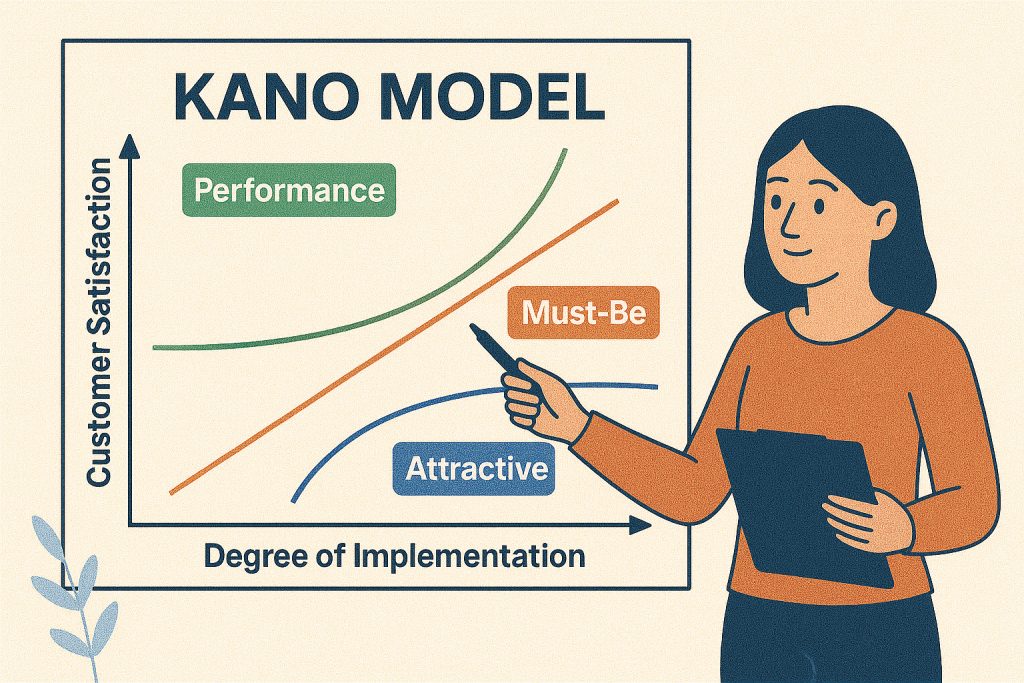What is the Kano Model?
Picture this: your product team has a dozen promising features on the table, each vying for development resources. How do you decide which ones will truly matter to your users? Enter the Kano Model—a framework that cuts through the complexity by focusing on one crucial question: how will each feature make your customers feel?
Unlike other prioritization methods that juggle multiple criteria, the Kano Model maintains laser focus on customer satisfaction. It recognizes a fundamental truth about product development: some features create excitement when present but don’t hurt when missing, while others are absolutely essential for basic functionality. This nuanced understanding of customer psychology makes it an invaluable tool for teams serious about building user-centered products.
What is the History of the Kano Model?
The framework emerged from Dr. Noriaki Kano’s groundbreaking research at Tokyo University of Science in 1984. As a professor studying quality management, Dr. Kano was investigating what truly drives customer satisfaction and loyalty. His findings challenged conventional thinking about feature development.
Rather than assuming all features contribute equally to user happiness, Dr. Kano discovered that customer reactions follow predictable patterns. Some features, when executed poorly, immediately frustrate users. Others provide steady, linear satisfaction as you invest more in them. The most intriguing category consists of features that surprise and delight users in ways they never expected.
This research revealed that successful product development isn’t just about adding more features—it’s about understanding the emotional landscape of user needs and strategically addressing different types of expectations.
How Does the Kano Model Work?
The model operates through a two-dimensional evaluation system that balances customer satisfaction potential against implementation investment. Teams begin by listing potential features, then categorizing each one based on its likely impact on user emotions.
The process starts with internal team discussions about feature categorization, but validation comes through direct customer engagement. Surveys, interviews, and feedback sessions help teams understand whether their assumptions about user reactions align with reality. This customer-centric validation separates the Kano Model from purely internal prioritization methods.
What makes this approach particularly powerful is its recognition that satisfaction isn’t linear. Doubling your investment in a feature doesn’t necessarily double user happiness. Some features provide outsized emotional returns, while others offer diminishing benefits despite significant resource allocation.
What are the Kano Model Feature Categories?
The framework identifies three categories of features worth pursuing, each requiring different strategic approaches.
Threshold features represent your ticket to market participation. These are capabilities users assume will work properly—like reliable email delivery in a communication app or accurate search results in an e-commerce platform. Users don’t celebrate these features when they work well, but they become immediately frustrated when they don’t. The challenge lies in recognizing that while threshold features don’t differentiate your product, they’re absolutely essential for credibility.
Performance features follow a predictable satisfaction curve. More investment yields proportionally more user happiness. Processing speed, storage capacity, or feature completeness often fall into this category. These are the capabilities users actively compare when evaluating competing solutions, making them crucial for competitive positioning.
Excitement features offer the highest potential for creating memorable user experiences. These innovations surprise users in delightful ways they hadn’t anticipated. Their absence doesn’t create dissatisfaction, but their presence can generate disproportionate enthusiasm and word-of-mouth marketing.
Let’s examine how these categories play out in real product scenarios:
Example 1: A music streaming app considers adding offline download capability. For users with limited data plans or poor connectivity, this becomes a threshold feature—they expect it to work reliably. The satisfaction comes from seamless functionality, not from the feature’s mere existence.
Example 2: The same music app explores AI-powered playlist generation based on mood and activity. This represents an excitement feature because users didn’t know they wanted it until they experienced it. When it works well, it creates genuine delight and becomes a talking point.
Example 3: Adding more audio quality options (128kbps, 256kbps, lossless) functions as a performance feature. Audiophiles will be progressively more satisfied as quality increases, and they’ll actively compare these options when choosing between competing services.
Tips for Categorizing Features:
- Test your assumptions with real users: What seems like an excitement feature to your team might actually be a threshold expectation for your audience. Customer interviews and surveys help validate your categorizations before you invest development resources.
- Consider your competitive landscape: Features that were once exciting often become threshold requirements as competitors adopt them. Regularly reassess your categorizations based on what users now expect from products in your category.
- Think beyond demographics: Users in the same age group or profession might have vastly different feature expectations based on their experience level, usage patterns, or personal preferences. Segment your research accordingly for more accurate categorization.
The model also identifies two feature types to avoid:
- Indifferent features that consume resources without affecting user satisfaction
- Reverse features that actually annoy users when implemented
Understanding these distinctions helps teams allocate resources more strategically, focusing on features that will genuinely impact user experience rather than just adding functionality for its own sake.
When Should You Use the Kano Model?
This framework proves most valuable when teams face resource constraints and need systematic guidance for feature prioritization. It’s particularly effective for organizations trying to balance competing demands: meeting basic competitive requirements, investing in performance improvements, and identifying breakthrough innovations.
The model works best during strategic planning phases when teams have identified more potential features than they can reasonably develop. Rather than making decisions based solely on technical feasibility or stakeholder preferences, it provides a structured way to evaluate options through the customer impact lens.
Teams building consumer-facing products often find the model especially useful because it helps them understand the emotional journey of their users. B2B product teams can also benefit, though they may need to adapt the framework to account for different decision-making processes and stakeholder influences.
Successful implementation of the Kano Model typically requires several key elements:
- Direct customer access for conducting surveys and gathering authentic feedback
- Cross-functional collaboration between product, design, and engineering teams
- Regular reassessment cycles to account for evolving customer expectations
- Clear communication channels to share findings across the organization
The approach also helps prevent common development pitfalls. Many teams invest heavily in features that seem technically impressive but don’t meaningfully impact user satisfaction. The Kano Model’s emphasis on customer emotional response helps teams make more balanced, user-centered decisions.
However, the framework requires significant customer research investment. Teams without direct user access or those serving highly diverse audiences may struggle to apply it effectively. Additionally, customer expectations evolve over time—yesterday’s excitement features often become tomorrow’s threshold requirements, necessitating regular reassessment of feature categorizations.
Kano Model Takeaways
The Kano Model’s enduring relevance stems from its fundamental insight about human psychology: people don’t experience all product features equally. Some capabilities feel essential, others provide steady value, and still others create moments of genuine surprise and delight. By acknowledging these different emotional responses, product teams can make more strategic decisions about where to invest their limited time and resources.
This framework reminds us that behind every feature request lies a human being with specific expectations, frustrations, and potential for excitement. In our data-driven age, it’s easy to lose sight of these emotional dimensions of product development. The Kano Model brings them back into focus, encouraging teams to think deeply about how their decisions will make users feel rather than just what functionality they’ll provide.
The model also highlights the dynamic nature of customer expectations. Features that once delighted users eventually become basic requirements as markets mature and competitors catch up. This evolution requires teams to continuously reassess their feature strategies, ensuring they’re not just meeting today’s expectations but anticipating tomorrow’s.


